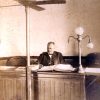calsfoundation@cals.org
Thomas J. Lacy (1806–1849)
Thomas J. Lacy was a leader of the Arkansas legal community in the early days of statehood. One of the original members of the Supreme Court of Arkansas, he served for nine years before ill health forced him to step down in 1845.
Thomas J. Lacy was born around 1806 in Rockingham County in North Carolina. The son of Batie Cocke Lacy and Elizabeth Overton Lacy, he was educated at what became the University of North Carolina at Chapel Hill, reportedly graduating at the top of his class in 1825. Following graduation, he read law in the Springfield, Kentucky, office of John Pope, an ally of Andrew Jackson who would later serve as territorial governor in Arkansas.
From Kentucky, Lacy moved to Nashville, Tennessee, where his mother had family. When he was appointed a territorial Superior Court judge in 1834, he relocated to Arkansas and settled in Monroe County. In 1835, while still sitting as a judge, he was elected to serve as a delegate to the Arkansas constitutional convention, which was creating the state government. The new constitution called upon the state legislature to elect the first group of justices slated to serve on the Arkansas Supreme Court, and Lacy, along with Daniel Ringo and Townsend Dickinson, made up the initial High Court membership. By lot, Lacy’s initial election was for four years, but he was reelected to a full eight-year term in 1840.
Lacy’s tenure on the court was not without controversy. In 1840, he issued a particularly controversial decision in a banking case when he and Justice Dickinson upheld the validity of the assignment of assets of the Real Estate Bank to trustees according to a plan drafted by influential Arkansan Albert Pike. However, the plan actually represented an effort to secure control of the bank. While Lacy and Dickinson offered a detailed decision supporting their ruling, it was not well received among some segments of the legislature. It led to calls for impeachment, while also raising fears that Lacy’s candidacy for reelection might be imperiled. However, the furor died down when Pike secured outside opinions from leading jurists James Kent of New York and Joseph Story of the U.S. Supreme Court, who fully supported the Dickinson-Lacy ruling.
With the controversy put to rest, Lacy was reelected. Meanwhile, legal experts have generally ranked his decision in Moody v. Walker as his most influential opinion. In that ruling, Lacy laid out a number of basic precepts in property law, conclusions that would serve as the foundation for generations of common law interpretations on subjects such as life estates and future interests. In addition, Lacy’s dissent in the 1842 case State v. Buzzard represents an early articulation of the right to bear arms as a central part of one’s right to defend oneself, a right, he argued, that was unassailable and separate from any broader, militia-based permission. In general, Lacy’s work as a jurist was well regarded. In the view of one court observer, Lacy brought an “effervescence and elan” to the court, while adding a broader perspective to its opinions. Overall, his work earned the respect of attorneys throughout the state.
In 1844, ill health required Lacy to go to New Orleans, Louisiana, for surgery. His return to Arkansas coincided with the death of his wife. The couple had no children. On June 7, 1845, still struggling with his health, Lacy resigned from the Supreme Court and relocated to New Orleans. Despite continuing health problems, Lacy soon developed a thriving law practice. His health continued to decline and on January 11, 1849, at the age of forty-three, Lacy died of cholera. He is buried in New Orleans.
For additional information:
Hallum, John. Biographical and Pictorial History of Arkansas. Albany: Weed, Parson’s and Company, Printers, 1887. Relevant selection online at http://files.usgwarchives.net/ar/state/bios/lacytj2.txt (May 17, 2017).
Looney, J. W. “Thomas J. Lacy: Superior Court Judge and Supreme Court Justice of Arkansas.” Arkansas Lawyer 49 (Winter 2014) 48. Online at https://issuu.com/arkansas_bar_association/docs/the_arkansas_lawyer_winter_2014?mode=embed (accessed May 17, 2017).
William H. Pruden III
Ravenscroft School






Comments
No comments on this entry yet.